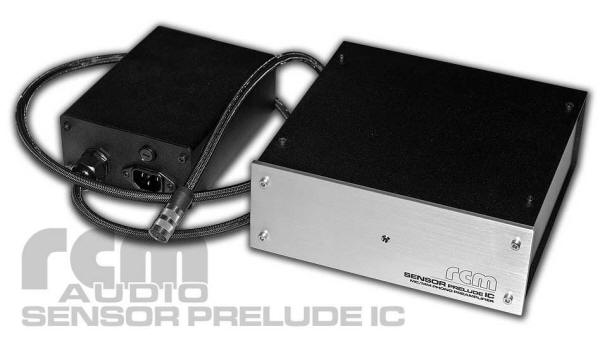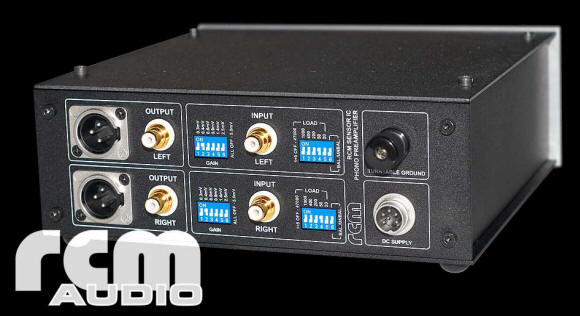This is a very good time to be an audiophile. We all benefit from the bewildering explosion of extremely expensive gear, targeted at the few with unlimited budgets. Those buyers fund the R&D that enables trickle-down technology that makes possible great sounding and affordable components. The availability of great sounding affordable components is why this is a good time to be an audiophile.

The RCM Sensor Prelude IC phono preamplifier is a perfect example of this new breed that has a long list of strengths and very few weaknesses. By minimizing weaknesses, we, as experimental audiophiles trying to assemble a system that is both musically wonderful and realistic can focus our auditions on gear that fits a budget instead of trying to mix and match different sonic aberrations. As components become more neutral in overall tone and balance, they are more interchangeable. We can focus more on value and less on character. For your consideration today is a phono preamplifier that delivers remarkable value and rates highly for absolute sonic quality.
Other components on hand during the audition included a SOTA Cosmos IV vacuum turntable with Triplanar VII u2 tonearm, Basis 2500 Signature turntable with Vector 4 and MØRCH DP-8 tonearms, Miyajima Kansui, Benz LP-S, ZYX Omega-S and ZYX UNIverse phono cartridges, Whest PS.30RDT Special Edition phono preamplifier, Bob’s Devices CineMag 1131 “Blue” step-up transformer, Mark Levinson 326S preamplifier with phono, Prism Orpheus Digital Interface with custom Windows 7 computer/music server, YG Acoustics Kipod II Signature Main Modules speakers, Dali Mentor 5 speakers (from the home theater system), and Gallo TR-3 subwoofers. Power amplifiers included Mark Levinson 532H, Manley Snappers, and Spread Spectrum Technologies Ampzilla 2000 2nd Edition. Interconnects and speaker cables are mostly Mogami. The Firewire cable joining the music server and Prism Orpheus is Audioquest Carbon. All front end components receive their AC power from a PS Audio AV-5000 power conditioner which is connected to the wall power with Shunyata Anaconda CX power cord. Other Shunyata CX series power cords are used elsewhere in the system, and I use Jerry’s DIY power cords on the music computer and Levinson preamp. A PS Audio Quintet is normally used for the power amplifiers. The entire system is turned on and off from the Levinson’s remote control.
I have several pages of listening notes that all describe one thing: this is one very special phono preamplifier that could easily be that “end of the road” “get off the merry-go-round” “take to a desert island” “live happily ever after” component. It is enchanting, musical, and involving. Let’s do a deep dive and see why.
The $2995 (or, as reviewed, $3695 with Furutech upgrades) solid-state Prelude IC offers both RCA and XLR outputs, RCA inputs, has 7 steps of gain from 52-76 dB, resistive loading of 20, 50, 200, 400, 1000, and 47k Ohms*, and a very low signal-to-noise ratio of 85 dB at the 52 dB gain setting. All settings are easily accessible, which is how all phono stages should be designed. The preamplifier is housed in a separate enclosure from the power supply and both units are well made and substantial. I listened to both XLR and RCA outputs and preferred the RCA connections.

*My Miyajima Kansui seems to perform best with loading at about 300 Ohms. This is available with the Prelude IC by turning on both the 1000 and 400 Ohm switches (http://www.1728.org/resistrs.htm).
Bass notes have real power and also real staying power, with a long and natural fade. The lowest notes can be thrilling with the awesome roar of thunder or bring an acoustic bass into the listening room with the delicacy of a single plucked string. Each note starts and fades in its own proper time, not the slow, edge-blunting beginning of a note or the quick fade we hear from inferior products. The midrange is a perfect marriage of the best qualities of tube and solid-state sound: natural warmth combined with focus and clarity. Simply wonderful!
Music from Thelma Houston and Pressure Cooker clearly demonstrates the excellent pace and timing. The performance of this high-energy large band is outstanding as they sound unusually together and in sync. An increased sense of cooperation and practiced perfection is evident in all music. The listener’s toe-tapping will surely reach new levels of participation. Whether listening to the smoky voice of Sade, the rocking sax from Clarence Clemons and The Boss’ E Street Band, or your favorite classical symphony, chamber music, country beer/truck/love story, acoustic, pop, or show tunes, the startling realism of all music provides for constant immersion in the music.
At the beginning of “Easy Does It” on Supertramp’s Crisis? What Crisis? LP, the whistling has uncanny body and is very natural and believable. The footsteps demonstrate an excellent lateral imaging ability, and the traffic sounds offer a good sense of the acoustics – yes, even in open air – plus a superb perception of depth.
The treble is sweet but detailed and serves over 90% of all LPs perfectly. This 90% includes most non-audiophile recordings which usually have some sonic blemishes, often attributable to the equipment or studio processes used to make the final 2-track mix. These LPs can sound hard or tizzy which can make cymbals, for example, sound more like white noise than ringing metal discs. With the RCM Sensor phono preamp, these recordings sound excellent. The Prelude IC seems to commute some sonic flaws to offer beautiful music without sounding rolled off, soft, or dark. The Prelude IC offers the upper frequency presentation of very fine tubes, but with much lower internal noise.
The Whest PS.30RDT Special Edition phono preamplifier ($7200) is very good overall. It seems to be able to bring out the very best from your very best recordings. It is quite transparent which can sound unpleasant if the source is compromised. Such is the cost of accuracy. It has a somewhat bigger sound which is a combination of a taller soundstage and a very small amount more high level dynamic contrast. The Prelude IC presents a slightly deeper soundstage. The Whest digs down a bit farther into the extremely low level texture of sounds providing more relief of nearby instruments and singers which are separated with greater isolation and depth. Very low level resolution in the upper frequencies is greater with the Whest phono stage, but this can actually detract from the ability to enjoy those less than excellent recordings we all keep in our collections. Average LPs – that 90% – usually sound more pleasant when their small defects are not so exactly revealed. Where the Whest can sound a bit analytical with some LPs, the Prelude IC is always musical without sacrificing musically important resolution.
There seems to be a sonic barrier being broken here. The Prelude IC might not be quite a laboratory instrument, but it easily qualifies as a musical instrument. It is almost impossible to proclaim that any character we discuss in audio reviews is better or worse than another character or sonic signature. Everything must be taken in context of the system in which it is evaluated. The RCM Sensor Prelude IC phono preamplifier involves the listener with an inner truthfulness that moves every performance one noticeable step closer to live music.
Overall Rating: 9.5 LPs
Link to distributor: SORAsound
My thanks to Mehran at SORAsound for his very kind assistance with this review.
